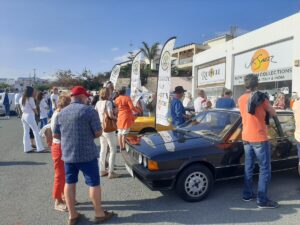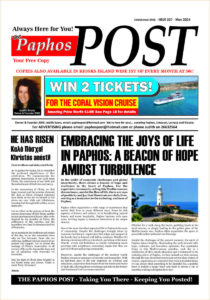Tourist arrivals hit all time high
By Bejay Browne
Tourist arrivals for 2018 were the highest ever recorded in a period of one year, according to the statistical service,Cystat.
Just under four million tourists visited Cyprus in 2018, a 7.8 per cent increase compared with 2017. From January to December 2018, 3,938,625 tourists visited Cyprus , compared to 3,652,073 in 2017.
In addition, December 2018 was a record-breaking month, which saw 106,563 tourists arrive in Cyprus, this is a 7.8 per cent increase compared with the same period in 2017,which was 98,924.
Arrivals from Britain increased in December by 13.6 per cent and from Greece by 13.5 per cent. However, an 18.8 per cent decrease was recorded for Russian arrivals and also arrivals from Israel fell by 7.2 per cent.
According to Cystat figures, Cyprus remains a popular destination with British holidaymakers who topped the numbers at 30.1 per cent, followed by Greece at 14.8 per cent, and Russia and Israel at 9.4 per cent and 8.7 per cent respectively.
Paphos gets clean bill of health after audit on major projects
By Bejay Browne
Paphos municipality has successfully passed an audit examining the implementation of co-financed projects in the town, it announced.
“Paphos municipality is fully satisfied with the results of the audit and everything was spot on. We are operating with full transparency and moving forwards, distancing us from the scandals of the past,” said a municipality spokesman, referring to the turmoil the town experienced just a few years ago after being hit by a deluge of scandals.”
The successful completion of the audit, which examined the four largest projects undertaken in the centre of the city, was achieved without any observations.
The projects were co-funded by using European Funds and the audit of the Internal Audit Service was carried out by Grant Thornton (Cyprus) Ltd.
“A letter to the municipality stated that there were no findings from the final audit report and informed the Paphos municipality that this audit was considered closed,” the spokesman said.
The four major projects came with a price tag of around €20 million in total: the upgrading of the Markideio theatre; upgrading Kennedy Square and the surrounding area and public roads; remodelling and revitalising the centre of Moutallos; and the connection of the small squares close to the town hall, namely, 28th October, Kostis Palamas and Dionysios Solomos squares.
“This result proves that the municipality of Paphos acted on all the projects on the basis of good administration, and following all the procedures provided.”
The letter from Grant Thornton Ltd also thanked the municipality for constructive cooperation, which, “has resulted in the adoption and promotion of measures that help to strengthen the management and control procedures of programmes funded under the Operational Programme ‘Competitiveness and Sustainable Development’.”
Mayor of Paphos Phedonas Phedonos announced the projects, along with others, to the public in 2016.
At the time he referred to the long list of Paphos corruption scandals and repeated his pledge for clean, transparent local government.
“We must fight to successfully meet the challenges of the times and create the conditions for a safe and orderly restart of the local economy, free from the errors and omissions of the past, from the unacceptable phenomena of rot and corruption that led Paphos to the brink of destruction,” he said.
He promised: “Paphos can become a model of good governance and serve as an example of proper service of the public.”
Unconventional Paphos-born composer has won awards for his monumental compositions
By Bejay Browne
The tak,tak of water into a bucket from a leaking roof, the whoosh of steam from a coffee machine in a busy cafe should hardly count as music to the ear.
But for Marios Joannou Elia, such sounds can become a symphony.
Meeting in a bustling coffee shop, the Paphos-born composer invites me to really listen to the cacophony of complex sounds around us: steam from the coffee machine, the general hubbub of the cafe, hum of chatter, the steady thump of background music on the radio, the occasional scrape of a chair being moved, a high pitched squeak as the glass door swings shut, and the rumble of passing traffic.
It suddenly becomes an all engulfing symphony of sound, the music track to this present moment and life experience, and this, he said, is the aim of his latest projects.
“The sound here is polyphonic, made up of all of the different layers. If you listen to the sound, it’s not just a noise,” he said. “I try to sort of analyse it and then use this in my projects, in fact we generally hear many noises at the same time, but don’t really listen.”
Elia has racked up more than forty international prizes for his unconventional creation of monumental musical events.
At present he is completing his ambitious project, ‘The sound of Kyoto’, a contemporary acoustic portrait of the Japanese city this year.
“The project’s goal and vision is to musicalise the entire city,” Elia said of the project which was selected by the Japanese city from 330 proposals. The composer, who was also the artistic director of Pafos2017, completed a similar project in 2017, the ‘Sound of Vladivostok’.
Next up for the 40-year-old international composer and sound musician will be writing the composition for a World Guinness Record for the largest matryomin ensemble with over 300 players in Kobe, Japan, for the 100th anniversary composition for the invention of the theremin , the unique instrument with antennas which is played without being touched.
(The matryomin is a ‘one antenna theremin’ which is inserted into a Matryoshika or Russian doll. Played in a mass, the process of creating the complex, powerful sounds by the instrument is similar to that of a choir.)
The work is being commissioned by the Russian and Japanese theremin schools.
Elia is a visionary, and is also working on a new large-scale work for trumpet solo, symphony orchestra and choir, a commission of the Kodaly Centre and Pannon Philharmonic in Pécs, Hungary.
He can often be found at various locations around the world, hanging off a precipice, or precariously positioned above a waterfall, equipped with his sound recording gear, and all to catch that one elusive sound.
For the last year Elia has spent much of his time in Kyoto doing just that, composing and gathering sounds that tell the story of the city in a unique way which he describes as a ‘mosaic of all different pieces that fit together’. Most of this process is being documented in a film which will be the culmination of the work which is due to be completed in around a year’s time.
Musicians, soloists, ensembles, choirs and orchestras, sounds that are unique to the city and other acoustic components, such as: sounds and representations of the river, Sumo, Geisha, and the Matryomin orchestra are all important aspects, he said.
His ‘exceptional academic performance’ was awarded by the Austrian Federal Ministry of Education, Science and Research in 2002, one of many accolades he has already collected through his career.
Recently he was also honoured by the government of Primorsky Krai in Russia and the mayor of Vladivostok “for the development of the musical art in the Primorsky territory and the invaluable contribution to its cultural development”.
These accolades relate to another of Elia’s large scale projects, the ‘Sound of Vladivostok’ which premiered at Cinema Vladivostok and saw 350 musicians take part.
“The entire city is the scenery and the stage on which the music is performed and the city’s voice is heard,” he said.
This result is accomplished by using a vast and eclectic array of sounds including, a symphony orchestra, several choirs, Korean drums, Soviet-era cannons, ships and air jets.
The project was awarded the Grand Prix ‘Silver Archer’ of the Far East and led to an invitation from the Japanese government in collaboration with the city of Kyoto and Kyoto Art Centre to work on ‘Sound of Kyoto’.
Paphos bus driver who won Hearts of Gold Cyprus
By Bejay Browne
An unassuming Cypriot father of two from Marathounda in Paphos is a a bus driver who’s much loved by all of his passengers.
Over the last 15 years, Panicos Chrysanthou, 41, has loaded up his bus and driven his passengers to their destinations across the island, five days a week, going over and above what could reasonably be expected from any bus driver anywhere in the world.
Chrysanthou is the driver of the Pasycaf (the Cyprus Association of Cancer Patients and Friends) bus, a free bus service that transfers all cancer patients, irrespective of their financial status, to other towns for treatment and back.
Every morning, the modest driver gets up at 4.30am, arriving at the Pasycaf centre in Paphos to take his passengers for oncology treatment in Limassol and Nicosia.
Almost painfully shy about being interviewed, Chrysanthou divulged the reason he became involved with the charity in the first place.
“I lost my mum to cancer when I was quite young and I wanted to help these patients who are experiencing what we went through, but we didn’t have any help,” he said.
His said that his mother Ellie, began to feel unwell and was diagnosed with a brain tumour. She underwent an operation but died eight months later.
“It was very hard, I was 18 years old and very close to my mum. It made me sensitive to people in this situation and going to Pasycaf is my way of helping,” he said.
The charity’s bus service started in 1998 with another bus driver and Panicos joined some years later, first working in the office. When the original driver retired in 2003, the charity offered him the job, as he is a qualified mechanic.
“Being the bus driver can be a difficult job. I get to know the patients, but I don’t think that I do anything special for people. I am just doing my job.”
His wife, Karen, a teacher at the International School of Paphos, disagrees.
“He does everything he can for his passengers, gets them on and off the bus, gets medication for them. If someone has to stay overnight and they have no-one to go and see them, he will go and sit with them for a little while just to keep them company. He will phone them to see if they’re OK, his phone doesn’t stop ringing. He doesn’t really finish work,” she said.
And his passengers agree with her, as for the last six years he has been nominated for a Heart of Gold Cyprus award scheme, founded eleven years ago to recognise both children and adults who are extra special in some way.
On December 2, 2018, at the annual ceremony SEK in Paphos, he was announced as the 2018 winner. The entire room erupted into spontaneous applause and gave him a standing ovation.
“I am happy to receive this award but I really don’t think I’m doing anything special,” he said.
The couple has two daughters, Ellie, 17, named after Chysanthou’s mother, and Angelina, 13.
When one of Ellie’s school friends, Jasmitha Marharaja Singh, who had fought a long battle with cancer was taken ill for the last time, he took great care of her family and those close to her. They all praise him highly for helping them through a terribly dark period. Jasmitha died aged just 15.
The couple met at school when Karen was 13 and Panicos, 14 and they have been together ever since.
Karen said that her husband’s phone is always ringing with cancer patients calling for all sorts of reasons.
“They ring for reassurance. He is like a security blanket in a way, helping them to do things when they’re at the hospital too, I know it can be very stressful for them.”
“It can be very hard. You make friends with the patients and then you lose them. For months or a year or more, you have patients that go every day and you get close to them. They chat to me, open up to me and tell me their problems.”
Sometimes he attends their funerals.
The best part of the job, he said, is when patients are waiting for their results and get the ‘all clear’.
“That is the absolute best,” he said.
President inaugurated revamped Paphos ‘Attikon’
By Bejay Browne
The newly revamped Attikon Hall, previously an abandoned cinema, was inaugurated by President Nicos Anastasiades in January.
The official opening ceremony of Attikon’ Hall, now used as a cultural centre, included a short film screening of clips from Greek and foreign cinema, said a spokesman for Paphos municipality. Mayor Phedonas Phedonos also addressed the event.
In addition, there was also a lecture by Professor Uriel Reichman, the President and founder of IDC Herzliya University, Israel. Herzliya is twinned with Paphos.
Attikon is steeped in local history and was renovated as part of Paphos’ 2017 Cultural Capital title.
It was founded in 1941-42 by Nikolas Taliotis (1911-2012) who converted an old warehouse owned by well-known Turkish Cypriot businessman and landowner Mustafa Ahmet Rasit Bey (1896-1963) into a cinema.
The spokesman said: “From 1950-1970 Attikon’ was an important place for the intellectual, cultural and social life of the town, hosting cinema screenings, theatre performances, commemoration events, lectures and other happenings.”
In the late 1970s the decline of Attikon began and it finally ceased to operate.
However, in the mid-1990s the venue reopened under the name of ‘Cine Othello’ and operated until 2000.
In 2015 the municipality promoted the renovation and conversion of the old space into a modern venue of cultural and conference infrastructure.
“The project (which was implemented during 2016-2018), was co-funded by the European Regional Development Fund and the Republic of Cyprus,” the spokesman said.
The architectural study was prepared by the technical services of Paphos municipality and the cost was around €1.9m plus VAT.
“The project aspires to the financial, cultural and social rejuvenation of the area and many later additions to the building were removed, as they distorted it’s character and authenticity.”
This has resulted in the creation of a multipurpose hall for activities and events, and an outdoor area useful for lectures, screenings and other events. This has been accomplished by reviving the former open-air cinema which operated at the back yard of the building, with a capacity of hosting around 240 people, he said.
Attikon flows into the adjacent space of Palia Ilektriki cultural centre, which creates a connection and cluster of projects of cultural and conference infrastructure in the centre of the old town.
“This is particularly important for the new face and identity of Paphos,” the spokesman said.
Bronze birds stolen from popular Paphos statue
By Bejay Browne
Four birds that were part of a recently installed bronze statue ‘the girl with the sparrow’ in a square in Paphos old town have been stolen, much to the dismay of the creator of the piece, artist Yiota Ioannidou.
First, one of the birds was reported as ‘disappearing’ and the remaining three were taken some time in the following 24 hours.
Ioannidou told the Paphos Post that she is extremely upset about the theft and is appealing to the authorities to investigate.
In a strange twist, the Paphos-based artist received a telephone call from an unknown male caller, informing her that the first missing bird had been found by the olive tree, which was planted next to the statue as part of Ioannidou’s overall design.
However, the Paphos Post went to investigate, only to discover that all of the birds are now missing. The caller is not answering his phone, according to the artist.
“I am particularly sorry about the fact of the theft of the sparrow, and I say theft and not vandalism. There is a difference,” she said.
“Public sculptures belong to everyone and no one has the right to steal or destroy public property. I would also like to point out that the site is protected by security cameras in order to warn against further malevolent activities which interfere with public property,” she added.
The sculpture was made with the support of Paphos municipality and took the artist ten months to complete. The birds would not be easy to remove from the bronze rods to which they were attached, she said.
Ioannidou said that the sparrows are integral to the sculpture with one of them sitting carefully in the girl’s hand, as she gently holds it.
The artist said that the project will be restored immediately.
“I hope that in the future there will be no similar incidents.”
With commanding views of the town below and the Mediterranean behind her, the bronze statue of a child now sits atop a cushion and plinth crafted in marble, without the sparrow she was holding, and without the others perched beside her, under the branches of a recently planted olive tree.
“This is so sad. Who would destroy this lovely piece of work? It’s disgusting behaviour. I hope that they are caught and charged,” a passer-by told the Paphos Post.
‘The girl with a sparrow’ is the third work by the artist to be placed in the town, ‘The Little Fisher Boy’ and ‘Sol Alter’, a homage to Aphrodite, attract hundreds of visitors every day.
Another of her sculptures is found in Argaka and honours rural mothers.
Born in Paphos, Ioannidou studied at the School of Fine Arts in Athens, before returning to Paphos.
Chlorakas gets new outdoor gym
By Bejay Browne
Chlorakas in Paphos has acquired a new outdoor seaside ‘gym’ and a new school and football pitches are also planned, all part of a push to upgrade the area, led by the head of the local community council.
Nikolas Liasidis announced that an outdoor gym was acquired, which is located in the area of Rodafinia, near Akti Beach and King Evelthon Hotels.
He added that the exercise area had been created in the framework of the upgrading of the Chlorakas coastal pedestrian pathway, after the community council voted in favour of a series of smaller and larger projects for the improvement and enrichment of the coastal walkway.
Other works include the construction of a restaurant, public toilets in busy areas, planting trees and shrubs, the placement of waste baskets and bins for dog faeces and the placement of sculptures designed by the University of Neapolis at points of interest, and lighting installations along some parts of the walkway.
In addition, the creation of a new beach and breakwaters in the area will hopefully get underway this year, according to officials. The beach will also be the first ‘organised and safe area’ for locals and tourists to enjoy, according to Liasidis
The community board also announced that they have succeeded in buying 19,500 square metres in the area of King Evelthon and a neighbouring piece of 19,500 square meters by the Holy Metropolis of Paphos for the Chlorakas Ecclesiastical Commission, meaning that a total of 39,000 square metres will now be able to be used for public purpose.
“This particular piece is ideal for the creation of the 3rd Elementary School in Chlorakas that our community needs, and also for the creation of two football fields that will strengthen the infrastructure of the area in the field of sports tourism,” announced the council.
Chlorakas is a popular place to live and visit and also home to a large community of expats of all nationalities. According to the 2011 census, it has 5,356 inhabitants, and this number has grown in the last few years.
It has numerous churches, tavernas, cafes, a shipwreck, a couple of museums, an outdoor theatre and stunning views of the coast.
Friendly kestrel rescued in Paphos
By Bejay Browne
A friendly young kestrel made its way to Nicosia to be nursed back to full health after a dog-walker found him lying on a pavement in Geroskipou in Paphos.
Ahead of his trip to the capital, the bird of prey, which is extremely affable, was being looked after by Andreas Evlavis, secretary of the Paphos Green party.
“He (or she) was unable to walk and it seems that he has a broken leg, he is small and seems young and not afraid at all, he is really lovely,” Evlavis told the Paphos Post.
According to BirdLife Cyprus, the bird, most probably a juvenile, is a common kestrel (Falco tinnunculus) and is widespread in Europe, Asia, and Africa.
Common kestrels measure about 32–39 cm from head to tail, with a wingspan of 65–82 cm and are small compared with other birds of prey.
They hunt, searching for prey by hovering about 10–20 m in the air, they have good eyesight and eat mostly small mammals. Once prey is sighted, the bird makes a short, steep dive toward the target. The common kestrel adapts to human settlement, as long as sufficient swathes of vegetation are available.
BirdLife Cyprus is a registered NGO that works to conserve wild birds, their habitats and wider biodiversity in Cyprus, through research, monitoring, lobbying, conservation and awareness-raising actions.
The dog walker posted photos of the bird on Facebook appealing for help and members of the public then contacted Evlavis for help, who turned to Green Party MP, Chralambous Theopemptou, for advice.
Theopemptou said that the bird will be transported to one of the two specialist facilities on the island, where it will be nursed back to full health.
“The bird will go the forestry department facility and be looked after very well.”
The second such facility on the island is operated by the game fund.
Theopemptou noted that as people are setting out poison for rats, mice and foxes as well as those that leave poison meat to prevent hunters from going on their land, the numbers of such birds are dwindling and they are becoming a rarer sight.
“The birds eat this meat and die, it’s not only the dogs that suffer. We are losing many birds this way,” he said.
The rescued bird took a liking to Evlavis, who was feeding him raw chicken as advised, and choose to climb all over him, even sitting on his shoulder as he went about his work at the Green Party office in Paphos.
“Hopefully this lovely bird will be full restored and released in the near future to carry on living in the wild,” he said.











